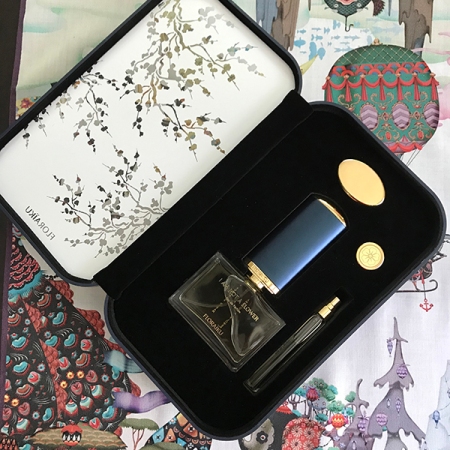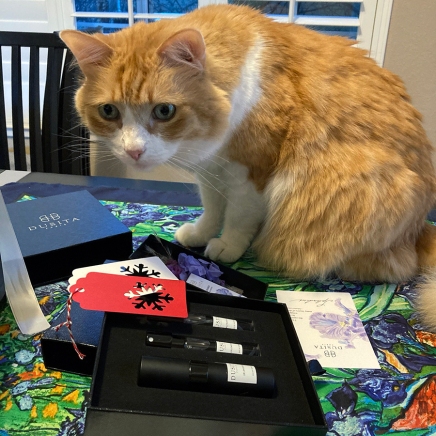It has been a minute (well, to be precise, 1,310,643 minutes) since I did a post in this series last time. I’m not traveling much, and combined with my “no/low-buy” policy, it is not a fruitful ground for getting suitable materials. But recently, thanks to IG, I gained access to some perfumes I wouldn’t have tried otherwise. So, I decided to revive the series.
About a month ago, I stumbled upon Memo’s IG post offering a free sample of Madurai, perfume I haven’t tried before. I didn’t really believe they would send anything, but I decided to try… And this week an envelope came with Memo printed on it. An envelope. I touched it and thought: Oh, no… Not a scented blotter or a perfume sachet…
I was pleasantly surprised. This sample is a clever one! You pull a paper tab, and then you can spray perfume from a tiny nozzle squeezing the packet.
 But enough about packaging (though, I am still impressed!). What about perfume? Madurai is a part of the Memo’s Fleurs Bohèmes collection. Created in 2022 by Gaël Montero, it has the following notes listed on the brand’s site: Turmeric Essence, Sambac Jasmine, Absolute Peach, Italian Bergamot Oil, Clary Sage Oil, Indian Tuberose Absolute, Egyptian Jasmine Absolute, Tagete Oil from Madagascar, Australian Sandalwood oil, Suede Accord.
But enough about packaging (though, I am still impressed!). What about perfume? Madurai is a part of the Memo’s Fleurs Bohèmes collection. Created in 2022 by Gaël Montero, it has the following notes listed on the brand’s site: Turmeric Essence, Sambac Jasmine, Absolute Peach, Italian Bergamot Oil, Clary Sage Oil, Indian Tuberose Absolute, Egyptian Jasmine Absolute, Tagete Oil from Madagascar, Australian Sandalwood oil, Suede Accord.
Had I known the notes beforehand, I might have skipped requesting Madurai, as it contains two ingredients – peach and tuberose – that almost never work for me in perfumes. Jasmine is also tricky for me: while I do not mind it in a supporting role, as a main player it usually wears me out, even in the most iconic and masterful creations. But I didn’t check dental hygiene of the proverbial horse before signing for a sample or testing it. And it was the second pleasant surprise.
I liked Madurai from the first sniff. It starts as a sweet floral composition. But despite the promised peach, it is not your standard fruity floral we all love to hate: if you keep sniffing it very intentionally, you might conjure something reminiscent of a peach, but I do not perceive it edible in any way or form.
It is interesting that the perfumer chose to use two different kinds of jasmine. It almost makes me want to get these raw ingredients to compare. (I probably won’t.) Jasmine in Madurai is present and recognizable, but it is a lot less heady than in many jasmine-centric perfumes I’ve smelled. As to tuberose… If any of you tried this perfume, please tell me whether you recognize tuberose in it. I don’t, but this is a good thing since I strongly dislike this note in most perfumes I tried.
At some point in the development I distinguish sandalwood, and I can probably agree with the suede accord (though, do not expect it to be as present as in Bottega Veneta or even Jo Malone Peony & Blush Suede). Turmeric? I don’t know… But I don’t care either way. These days it’s in everything, so why not in perfumes?
I don’t think Madurai is groundbreaking or extremely original, but somehow this particular combination of notes came together in a way that has me researching prices. I think Memo’s bottles are very attractive. But I can’t buy a 75 ml bottle after a single try, and even then, do I need or even have space for that bottle? Probably not. I was tempted by a travel spray from the brand, but in the interest of adhering to my low-buy resolution, I decided to go for a decant from ScentBird (no affiliation): even as a one-time purchase, their price is a lot more reasonable ($21.95 for 8 ml) than that from Memo ($70 for 10 ml), and with a subscription, you can save even more.
Speaking of reasonable prices. While Memo’s aren’t (but whose are these days?), they have an appealing and reasonable sampling program: you can choose a set of any 7 samples for $40, and they offer a $40 coupon off your future $150 purchase.
Image: my own





























 According to the
According to the 




